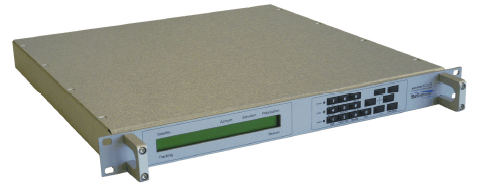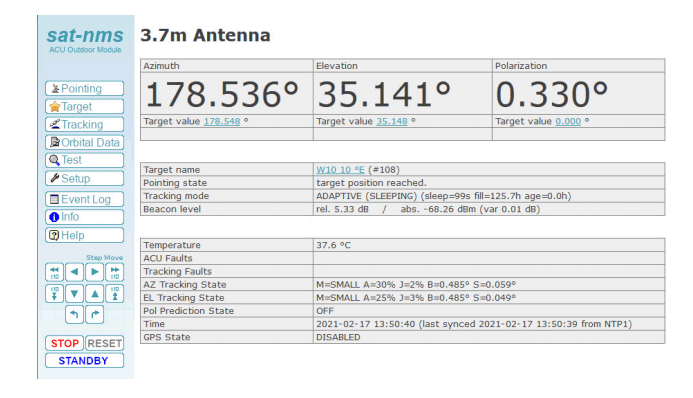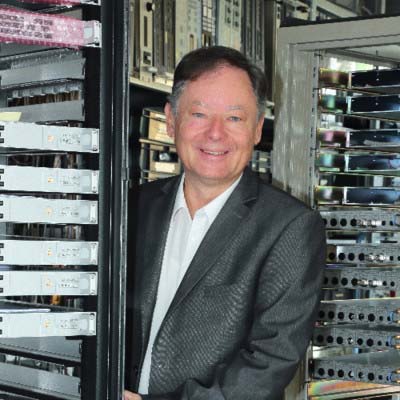The SatService Antenna Control Unit sat-nms ACU2-19V2 provides an excellent field replacement for the discontinued ACU 7200 from GD Satcom. Compatible with the SatService sat-nms MNC and the Calian Mon-A-Co monitor and control systems, the sat-nms ACU2-19V2 has a web-based user interface along with other standardized interfaces making it simple to integrate into existing SATCOM antenna monitor and control infrastructure. With improved SatService specific firmware capabilities and its effective user interface the sat-nms ACU21-19V provides an excellent means of cost-effectively upgrading antenna systems.
SatService has in the meantime delivered 400 sat-nms ACUs in different configurations, both for new installations or as upgrades of existing satcom antennas. The antenna diameter of these antennas ranges from 1,8m to 32m. The track record of ACU upgrades covers almost all worldwide antenna manufacturers like for example ASC, Andrew, Vertex, GD Satcom, Scientific Atlanta, ViaSat, NEC, Siemens, TIW and Patriot. Ask SatService if you have another type and we can do it for you.
The Requirement
SatService was approached by customers who asked for an alternative when the production of the Vertex 7200 ACU was discontinued. A typical system installed at the customer site is a 7150-drive cabinet located outside close to the antenna mount, several cables routed from this drive cabinet to the 7200 ACU which is installed indoors in a 19” rack. If an ACU 7200 fails and no spare parts are available but the complete outdoor system is still in good working condition, the teleport operator may not want to spend the money for a complete exchange of all the indoor and outdoor equipment.
The Idea
SatService has a proven antenna tracking design which is very well established and accepted in the market for more than 10 years. Until now SatService concentrated more on complete outdoor solutions (sat-nms ACU2-ODU-AC) which are directly installed at the satellite ground station antennas and required, beside the mains voltage, only a LAN interconnection to the building. But this is all only packaging around the sat-nms ACU2-ODM core module which includes all the intelligence and software algorithms.
Based on this experience the idea was born to develop a 19” 1RU drawer which is hardware compatible with the 7200 ACU. The goal is that the integrator will find all matching and compatible connectors, so that they can easily exchange units.
The Solution
The sat-nms ACU2-19V2 19” 1RU rackmount unit presented on the next pages is the result of these development activities. It includes the complete functionality of an antenna tracking controller with all the hardware interfaces necessary to exchange it against a 7200 ACU drawer.
To be even more universal the sat-nms ACU2-19V2 provides three different angular encoder interfaces:
• analogue resolver
• optical encoder with SSI interface
• analogue DC interface for potentiometer
 |
| SatService's sat-nms |
The front panel design is typical of the sat-nms products which allow management of the controller from the front panel LED display as well as keyboard and display. Nevertheless, the most common method of access for standard operations would be through its browser-based user interface or via the established monitor and control system. Equivalent functionality can be obtained through any of the interfaces selected above. Especially the set-up of the antenna controller and tracking system but also the daily operation is performed via the web browser GUI which is also presented here.
 |
| sat-nms front panel |
At the rear panel the sat-nms ACU2-19V2 provides a set of connectors which matches to the ones of the 7200 ACU.
 |
| sat-nms rear panel |
• J6 PL Encoder (interface to polarization angular encoder, either resolver or SSI interface)
• J7 EL Encoder (interface to elevation angular encoder)
• J8 AZ Encoder (interface to azimuth angular encoder)
• J9 LAN Remote (Ethernet interface for Web GUI and SNMP, and to sat-nms LBRX beacon RX)
• J10 Drive Interface
• J11 Digital Inputs
• J14 RS232 (not used)
• J16 RS422
• J17 RS422
• J21 Analog in (interface to other vendors beacon receiver)
• TB1 Alarm
• J5 PL2 Encoder (for 4th axis option)
• TB1-2 LP/CP SW (for 4th axis option)
Both analogue resolver and/or optical encoder with SSI interface can be connected to the sat-nms ACU2-19V2. This has to be defined at the time of order, as the necessary daughter cards will be installed accordingly.
The Hardware
The key module within the 1RU 19” unit is the sat-nms ACU2-ODM module. This is the module which provides all the hardware interfaces to the drive system (frequency inverters are most common, but could be also servo or DC motor drivers), the antenna limit switches, and axis encoders, etc. In the case of this special sat-nms ACU2-19V2 19” drawer a printed circuit board (PCB) was designed which transfers all the interfaces at its rear panel in the right way to be compatible to the ACU 7200. In addition to that the unit also provides an ethernet interface via which the customer has full access to the integrated web server for operational purposes and remote interfaces like SNMP and http protocol for M&C.
Independent from the development of the sat-nms ACU2-19V2 version also the core sat-nms ACU-ODM module was upgraded with a new more powerful processor to cover the requirement for more CPU power and firmware capability. The result is the new core module sat-nms ACU2-ODM, in which the 2 expresses the next generation. This will also be delivered in future in all other SatService antenna controller configurations.
The Firmware
As already explained, the sat-nms ACU2-19V2 is from the interfaces point of view hardware compatible to the ACU 7200, whereas the firmware including tracking- and adaptive models-algorithm is SatService’s complete own development and implementation.
The sat-nms ACU is implemented on a modern firmware architecture and has a proven track-record of performance in a variety of satellite networks over several years. The firmware design allows for continued product and algorithm improvements and will be constantly supported and also maintained. Just recently SatService performed a significant update of the firmware, and in case of the 4th axis interface also the hardware. This led to a significant expansion of functionality, like for example:
- Orbit prediction based on TLE two-line elements data
- and Intelsat I11 data
- TLE and I11 editor and file manager
- polarization prediction, which is especially helpful for inclined orbit satellites
- NTP time synchronization
- jack screw protection mode
- sat-nms LBRX beacon receiver direct control
- space for 200 targets
- Tracking improved with “initial pointing mode” based on model, TLE or I11
- “4th axis” functionality can be covered as option
The Matching Beacon Receivers
All sat-nms ACU tracking systems are designed to interface also to any other vendors beacon receiver via the universal 0 to 10V ADC interface. But the more sophisticated solution would be to use our sat-nms LBRX, which no longer makes a 0 to 10V calibration necessary. The beacon receiver sat-nms LBRX transfers via UDP packets the exact beacon level information (for example -67.23dBm) to the sat-nms ACU2-19V2 and its internal tracking algorithm via its ethernet interface.
Multiple configurations of the sat-nms LBRX beacon receiver are available; small DIN rail mounted version, the sat-nms LBRX19 with 4 L-band inputs, the sat-nms LBRX19-81 with 8 L-band inputs (which allows for example C/Ku multifeed operation) and the beacon receivers which provide inputs at the direct receive frequency in C-band, X, Ku and Ka-band, so for example sat-nms KuBRX19.
Interfacing an Existing DTR Beacon Receiver
An RS232 interface with its serial protocol to the DTR beacon receiver is not implemented. But you certainly can continue to use the DTR if you switch to the analog (0…10 VDC) output. This is working fine and runs without any problems. But as already described you can avoid the DC output interface if you take a SatService beacon receiver, so then all devices communicate via the network.
The installation/integration workflow of the retrofit:
Our goal was to make the retrofit procedure from a 7200 ACU to a sat-nms ACU2-19V2 as easy as possible. Here is a short description of the
 |
| Screenshot of web interface of the sat-nms ACU2-19V2 |
tasks involved.
1. Stop step track at the 7200
2. Readout and write down azimuth, elevation and polarization values presented at the 7200 ACU
3. Switch off the circuit breakers in the 7150-drive cabinet, so that the antenna cannot move
4. Disconnect the cables from the ACU 7200
5. Remove ACU 7200 from the 19” rack
6. Slide in the sat-nms ACU2-19V2
7. Connect the three resolver cables to the sat-nms ACU2-19V2
8. Connect Ethernet to your local LAN
9. Connect mains voltage cable to sat-nms ACU2-19V2
10. Switch on the sat-nms ACU2-19V2
11. Configure the IP address so that it matches to your IP sub-net with @CHIPTOOL Software installed on a PC
12. Navigate with your web browser to this IP address and you will see the web interface of our sat-nms ACU2-19V2.
13. In the “setup” page you calibrate azimuth, elevation and polarization to the values which you wrote down from the old ACU 7200 under point 2
14. Then switch on each axis circuit breaker step by step at the 7150-drive cabinet and test motorization in each axis via the sat-nms ACU2-19V2 main “pointing” page.
15. Check the drive direction of each axis and if necessary, change it in the set-up page. We recommend not to move all three axes at the same time, do it step-by-step
16. Test limit switches in each axis, so that you are sure these are operational and working
17. Now the new antenna controller is operational and you can move all three axes
18. You can make yourself familiar with the operation of the sat-nms ACU2-19V2 and its tracking modes by using the handbook either in electronic or printed form.
19. SatService is always available to provide assistance. SatService can also provide training for the operator, or system integrator.
In summary, these are very easy steps to be performed and can be completed easily in 2 hours.
The Alternative:
If the station owner needs to retrofit the ACU 7200 indoor unit and also the 7150-drive cabinet, there are two choices:
• keep the indoor/outdoor approach
• select a complete outdoor version sat-nms ACU2-ODU-AC
In case (1) continue to go with a sat-nms ACU2-19V2 as described above and in addition order a retrofit plate sat-nms MCU-V-AC into the 7150-drive cabinet. In that case, simply use the existing cables between indoors and outdoors if they are in good condition.
A more common approach is to change to the sat-nms ACU2-ODU-AC complete outdoor solution. In this case (2), there is no indoor unit necessary at all. The sat-nms ACU2-ODU-AC easily interfaces to an antenna which up to now is connected to a 7150 drive cabinet and 7200 ACU indoor unit, entirely. The replacement system must be sized properly, this information can be generated from specifications of the inverters and motors on the antenna. Finally, to complete the interface of the new sat-nms ACU system, the type of resolver/encoder technology and specifications must be provided – sat-nms ACU accommodates a wide variety of types, including optical (with SSI interfaces) as well as the more common resolver-type encoders. Please specify at the time of order.
The RS232 Implementations:
As always in real world applications there are some limitations or restrictions which we are open to discuss. If the central monitoring & control system to which the Vertex 7200 ACUs are connected and you now want to install a sat-nms ACU2-19V2 instead, then the M&C protocol on its RS232 interface is no longer compatible with the protocol provided by the 7200 ACU. Certainly, SatService can provide an M&C command set via its RS232 interface but this is a different command set then provided by the 7200 ACU. In the existing customer installations that do not use the RS232 interface and have converted their M&C systems to a driver which interfaces to the sat-nms ACU2-19V2 via the existing SNMP MIB or http PUT/GET protocol. This is a much more common implementation than the RS232 interface.
However, SatService could also implement a sub-set of the 7200 RS232 protocol and command set if a customer does have a higher demand in terms of quantities to be replaced. Please consult the factory for further discussion.
Support
After-sales support is a priority at SatService GmbH. SatService take pride in its reputation for responsive and strong technical support. For this we provide you as a customer the following options:
Training: SatService quotes dedicated training to its customers. These are trainings specifically designed and performed to your specific requirements and also experiences.
Website: SatService provides all manuals and any other relevant information online on its web page: www.satservicegmbh.de/en/documentation.html
Support can be reached by e-mail at: support-satnms@satservicegmbh.de
Our Sales team can be reached by e-mail at sales@satservicegmbh.de or by phone at +49 7738 99791 20.
To Read or download a pdf of the full version of the White Paper on “Retrofit of ACU 7200 with sat-nms ACU2-19V2” at: https://satservicegmbh.de/tl_files/doc/application-notes/ACU2-19V2-WhitePaper-2021-03-24.pdf
Related Articles:
Calian Group Acquires Germany-based SatService for US$5.05 Million
LP Technologies and SatService Partner Anew at IBC Show 2018
------------------------------------------------
 Michael Ulbricht is the Managing Director of SatService GmbH, he can be reached at mu@satservicegmbh.de
Michael Ulbricht is the Managing Director of SatService GmbH, he can be reached at mu@satservicegmbh.de





